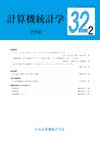Volume 32, Issue 2
Displaying 1-14 of 14 articles from this issue
- |<
- <
- 1
- >
- >|
-
2019Volume 32Issue 2 Pages Cover1-
Published: 2019
Released on J-STAGE: March 21, 2021
Download PDF (1974K) -
2019Volume 32Issue 2 Pages App1-
Published: 2019
Released on J-STAGE: March 21, 2021
Download PDF (1921K) -
2019Volume 32Issue 2 Pages i-
Published: 2019
Released on J-STAGE: March 21, 2021
Download PDF (56K) -
2019Volume 32Issue 2 Pages ii-
Published: 2019
Released on J-STAGE: March 21, 2021
Download PDF (31K)
Original Papers
-
2019Volume 32Issue 2 Pages 95-103
Published: 2019
Released on J-STAGE: March 21, 2021
Download PDF (989K) -
2019Volume 32Issue 2 Pages 105-117
Published: 2019
Released on J-STAGE: March 21, 2021
Download PDF (1430K) -
2019Volume 32Issue 2 Pages 119-133
Published: 2019
Released on J-STAGE: March 21, 2021
Download PDF (910K)
Reviews
-
2019Volume 32Issue 2 Pages 135-146
Published: 2019
Released on J-STAGE: March 21, 2021
Download PDF (303K)
Report of Activities
-
2019Volume 32Issue 2 Pages 147-158
Published: 2019
Released on J-STAGE: March 21, 2021
Download PDF (421K)
Editorial Board
-
2019Volume 32Issue 2 Pages 159
Published: 2019
Released on J-STAGE: March 21, 2021
Download PDF (139K) -
2019Volume 32Issue 2 Pages 160
Published: 2019
Released on J-STAGE: March 21, 2021
Download PDF (141K) -
2019Volume 32Issue 2 Pages 161
Published: 2019
Released on J-STAGE: March 21, 2021
Download PDF (129K)
-
2019Volume 32Issue 2 Pages App2-
Published: 2019
Released on J-STAGE: March 21, 2021
Download PDF (1906K) -
2019Volume 32Issue 2 Pages Cover2-
Published: 2019
Released on J-STAGE: March 21, 2021
Download PDF (1934K)
- |<
- <
- 1
- >
- >|
